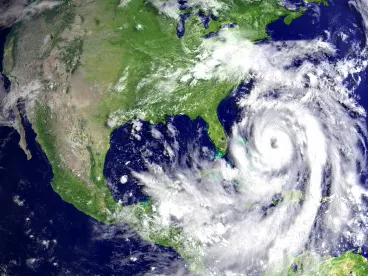The Internal Revenue Service (IRS) extended the deadline for certain disaster-area plan sponsors to file their annual returns for employee benefit plans on Form 5500 and relaxed the rules for loans and in-service hardship distributions for certain disaster-area participants under eligible defined contribution plans. The US Department of Labor (DOL) also relaxed its enforcement of a defined contribution plan’s deadlines for payroll contributions and certain participant notices in disaster areas. However, the Pension Benefit Guaranty Corporation (PBGC) announced that some of its required filings will not be extended automatically due to Hurricane Harvey.
IRS Extensions
For disaster-area plan sponsors, the IRS relief postponed the deadline for any Form 5500 previously scheduled to be filed between August 23, 2017, and January 31, 2018. In this case, the new Form 5500 deadline is January 31, 2018. This relief covers plan sponsors whose principal place of business is located in a listed disaster area. Businesses not in the covered area, but whose needed records for Form 5500 filings are in the covered area, are also entitled to the extended deadline.
Relief applies automatically to plan sponsors with an IRS address of record in the following Texas counties: Aransas, Bee, Brazoria, Calhoun, Chambers, Fort Bend, Galveston, Goliad, Harris, Jackson, Kleberg, Liberty, Matagorda, Nueces, Refugio, San Patricio, Victoria and Wharton. The list may be expanded as the impact of Hurricane Harvey is assessed.
PBGC Extensions
Likewise, the PBGC extended some of its required filings and premium payments. For a plan administrator or plan sponsor located in the IRS’ prescribed disaster area, the PBGC extended any premium filing required by a single or multiemployer pension plan between August 23, 2017, and January 31, 2018. In addition, for disaster-area plan administrators and plan sponsors, the PBGC extended deadlines between August 23, 2017, and January 31, 2018, for certain notices and plan asset distributions with standard and distress terminations of pension plans. In all of these cases, the new deadline is January 31, 2018.
However, the PBGC did not grant disaster relief for many of its filings. For example, the PBGC will not provide relief for certain filings where there may be a high risk of substantial harm to participants or the PBGC insurance program, such as notices of large missed contributions under section 302(f) of Employee Retirement Income Security Act of 1974 (ERISA), advance notice of reportable events under ERISA section 4043, and annual financial and actuarial information from certain controlled groups under ERISA section 4010. If a disaster-area plan administrator or plan sponsor is required to provide annual financial and actuarial information under ERISA section 4010 for a large underfunding, missed contributions or funding waiver, then the PBGC will consider reporting relief only on a case-by-case basis.
DOL Enforcement
The DOL also issued guidance for employee benefit plans affected by Hurricane Harvey. In addition to the Form 5500 extension, the DOL signaled relaxed enforcement of certain rules for benefit plans, such as delayed payroll contributions and loan repayments to retirement plans due to Hurricane Harvey. Relaxed deadlines also apply to blackout notices—where a defined contribution plan administrator must provide 30-day advance notice to participants and beneficiaries of any suspension or limitation on distributions, loans or investment directions of more than three days—and to claim deadlines and disclosures under group health plans. In all cases, reasonable accommodation will be made for a failure to comply with the established regulatory timeframes.
Plan Loans and Hardship Distributions
Finally, the IRS provided relaxed rules for disaster-area participants in defined contribution plans covered by sections 401(k), 403(a) or (b) and 457(b) of the Internal Revenue Code (Code) with respect to availability of plan loans and hardship distributions. To qualify for the relief, the plan participant either must have: (1) a principal residence on August 23, 2017, in one of the Texas counties identified for individual assistance by the Federal Emergency Management Agency, (2) a place of employment located in one of these counties on this date or (3) a lineal ascendant or descendant, dependent or spouse with a principal residence or place of employment in one of these counties on that date. If the eligible defined contribution plan currently does not provide for either loans or hardship distributions, then to utilize the IRS’ relief, the plan sponsor must amend its plan to permit such loans or hardship distributions no later than the end of the first plan year beginning after December 31, 2017 (an amendment deadline of December 31, 2018, for a calendar-year plan).
Hardship Distributions
For a qualified disaster-area participant, an eligible defined contribution plan may make any type of hardship distribution (not just the types listed in IRS regulations), based on the participant’s representations as to the required hardship amount, unless the plan administrator has actual knowledge to the contrary. The IRS guidance appears to expand permitted reasons for a hardship distribution, such as a hardship distribution for amounts to purchase necessities as a result of the storm, as long as the distribution is not in excess of the amount required to satisfy the need. The IRS guidance also permits plan administrators to suspend normal hardship substantiation and documentation requirements, provided that the plan makes a good-faith diligent effort under the circumstances to comply with required plan hardship documentation procedures as soon as possible.
In addition, the defined contribution plan does not need to impose the normal post-distribution contribution restrictions. For example, the participant may continue to make elective deferrals under Code section 401(k) without a six-month contribution delay. However, if an eligible defined contribution plan makes a hardship distribution to a qualified disaster-area participant, the normal tax rules still apply: (1) the amount of the hardship distribution is still limited to the maximum amount that would be available for hardship distributions under the plan, the Code and regulations, (2) the hardship distribution is still included in taxable income and generally subject to the 10 percent early distribution tax under Code section 72(t) and (3) the hardship distribution cannot include amounts from a qualified non-elective contribution (QNEC) account or a qualified matching contribution (QMAC) account.
Loans
An eligible defined contribution plan also may loan money to a qualified disaster-area participant if the plan makes a good-faith diligent effort under the circumstances to comply with required plan loan documentation procedures. For example, if a spousal consent is required for a plan loan, the plan will not be disqualified for making a plan loan without a death certificate if it is reasonable to believe under the circumstances that the spouse is deceased. Other than relaxed documentation, the normal Code requirements for plan loans still apply, and as soon as possible, the plan administrator must try to assemble any missing loan documentation.





 />i
/>i
